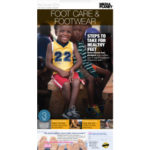By Vivienne Raper
Science, October 10, 2017 —
Allison McKendrick had her first child 18 months into her Ph.D. studies and was pregnant with her second when she interviewed for her postdoc. Right from the beginning of her career, “everyone knew we came as a package,” she says. So that she could continue to spend the time she wanted with her children after her parental leaves, McKendrick learned to focus on “getting the job done”—finishing experiments and writing papers—and became great at “zero time wasting,” she says. “I’m probably still more efficient than my peers because of the way I had to structure my working environment” early on as a scientist parent, says McKendrick, who is now the head of the optometry and vision sciences department at the University of Melbourne in Australia.
It wasn’t all perfect. When her children were young, McKendrick sacrificed long chats with colleagues in the coffee room and after-work networking, which she worried might damage her career prospects. She has also “sometimes wondered [whether] more time to ponder things luxuriously might have led to some grand idea” for her research, she says. But ultimately, scientist parents have to “make internal peace with the fact that you can’t do everything,” McKendrick says, adding that her personal experience has made her more open-minded to the “many different ways people [can] operate and still be productive.”
McKendrick’s experience illustrates just one of the many possible approaches that scientists can adopt as they balance starting a family with pursuing a research career. There’s no single right way to do it; it’s about figuring out what works for you and your family and tailoring your own solutions.

Lubomirkin on Unsplash
Planning for a leave—and a successful return
One of the trickiest challenges for expecting parents, particularly women, is navigating parental leave. Taking time off for a baby “is like stopping cycling halfway up a hill,” says Rachel Flecker, a professor of palaeoclimatology at the University of Bristol in the United Kingdom who had her three children while she was a lecturer (equivalent to assistant professor in the United States). “You have to stand hard on the pedals to get going again.” But some careful thought and planning can help you minimize the impact on your work.
One of the first things that early-career expecting parents should do is talk to their supervisors, university human resources departments, and funding bodies to find out what parental benefits they are entitled to and whether their studentships or postdoctoral contracts can be extended, Flecker says. With this information in hand, parents-to-be should then discuss with their supervisors the leave they are planning to take, which research commitments must be fulfilled before then, and arrangements for their return or next career step.
Many have found it helpful to get papers and conference abstracts into the submission pipeline before their leave. Flecker advises that researchers should identify the tasks “that need doing now so papers can be bubbling along in the review process while you’re on parental leave.” Laura Cocas, an assistant professor of biology at Santa Clara University in California, took this approach when she was a postdoc preparing for the birth of her first child. She “was very conscientious about finishing additional data collection” and submitting her work before taking her maternity leave, she says. Doing so meant that, “coming back, I only had to rewrite and finish the data analysis while sleep deprived.”
If experiments need to continue during a leave, consider creative solutions, advises Cocas, who recently returned from a second maternity leave. For example, Cocas arranged a collaboration between a pregnant graduate student in her lab and another student so that data collection could be finished during the new mother’s leave without her losing credit for the project, she says.
And if you want to keep working during your leave, there are ways to do that, too. McKendrick occasionally brought her babies to meetings with her Ph.D. supervisor so that she could “maintain some progress on the project and … continue writing” papers from home, she says. Olivia Carter, an associate professor of psychological sciences at the University of Melbourne, notes that new parents can benefit from remaining visible in their research community. When she took maternity leave for her first child 2 months after starting a tenure-track position, she worried this might cause colleagues to have a negative impression of her and limit future opportunities, she says. “I think there was a genuine question in people’s minds regarding the level of work that I would be able or wanting to achieve once a baby arrived,” she says. To alleviate these types of concerns, she notes that new parents can demonstrate continued engagement by helping organize conferences by email or blogging about research, for example—tasks that can be done in half-hour bursts while the baby sleeps. At the same time, she adds, there is no need to squeeze work into every available minute of parental leave.
For principal investigators, another key challenge is making sure that their labs run smoothly during their absence. During her second maternity leave, Cocas managed the day-to-day functioning of her lab from home and kept in regular contact with her students via Skype and email. The specifics, however, can vary depending on your career stage, as Carter found. During her first maternity leave, she dealt with the logistics of setting up a lab, which always involves delays, Carter says, so it worked out quite well. Having a second baby 3 years later was more disruptive because her most advanced students were only a couple of years into their projects and still needed a fair amount of guidance, which she provided from home. Then, by the time her third child was born, the lab had its own momentum and the senior graduate students could help provide continuity in her absence.
Ultimately, each new parent needs to decide what works best for them, whether it’s completely taking time off from work, diving right back into the lab, or anywhere in between. Then, they must do the necessary planning and communicating to make sure they’re on the same page as their bosses, co-workers, and collaborators.
Settling back in at work
Once your leave is over, the greatest challenge becomes pursuing the ever-elusive work-life balance. One strategy that worked for McKendrick and her family was being flexible about the distinction between “time to work” and “time at home,” she says. Upon returning to her Ph.D. lab after her first child was born, she took advantage of the university’s child care center and sometimes took her newborn with her to the office, doing computer work “while my little one was asleep in the pram,” she says. At home, McKendrick and her husband, who have developed parallel academic career paths, split the child care so that they could each work a little bit during their “home” time.
For Stephen Gitelman and Anna Bakardjiev, both faculty members in pediatrics at the University of California, San Francisco, and the parents of a 12-year-old and 9-year-old twins, the strategy has been to find reliable child care during the day and engage in “a constant give and take” to fill in the gaps and support each other, Gitelman says. Now that the children go to school, Gitelman and Bakardjiev still carefully plan their work commitments so that, when one has a deadline, the other can step up and attend to the children’s needs.
For others, the solution is to make more of a distinction between work and home. For the first 5 years of her daughter’s life, Katerina Michaelides, a senior lecturer in hydrology at the University of Bristol, had to keep her full-time workload to the standard hours of professional child care so that she could look after her daughter in the mornings and evenings as sole parent while her academic husband spent his weeks working at a university approximately 650 kilometers away. This meant that Michaelides had to be particularly selective in her work commitments, accepting invitations to collaborate on projects and speak at conferences only when they were “mission critical” for her career, she says. Although passing on such opportunities may come at a cost, one positive aspect of becoming a parent is that “you get better at prioritizing the important bits of your career,” she says. Having a child “focuses the mind.”
And despite the challenges, it’s useful to recognize that academia can offer some advantages for new parents, Michaelides says. “Ultimately, although academic life is intense, it comes with a certain amount of flexibility that allows you to change your working patterns as your personal life changes.” To make the most of this flexibility, it is important for expecting parents to proactively research their options, clearly communicate with the people they work with, and figure out what works best for them.












